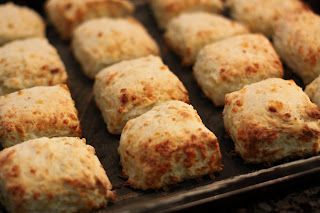There are a few recipes that I make so often, that they are scribbled out on post its and stuck to the fridge door - this is one of them. I got it from my mother's cookbook. She was an avid collector of recipes, she'd painstakingly cut them out of newspapers or magazines or jot them down on scraps of paper. Credit where credit's due, I think this recipe came from the monthly New Zealand Machine Knitters Society newsletter - always a treasure trove of tried and tested recipes.
The key to making a good light scone is not to handle the dough too much. When it comes time to add the liquid, do it swiftly and mix very lightly. This is a savoury scone, but you can make a sweet version by omitting the cheese, adding a tablespoon of sugar to the dry mixture, and then add dried ingredients of your choice. I like chopped dates and walnuts, or raisins and cinnamon with a pinch of mixed spice.
Cheese Scones
- 575 grams flour (about 4 and 3/5 cup)
- 3 teaspoons baking powder
- 1 teaspoon salt
- 100 grams butter, chopped finely or grated
- 300 grams grated cheese
- 450 mls milk
Method
1. Sift flour, salt and baking powder together.
2. Rub in butter with finger tips until it resembles bread crumbs and mix in the grated cheese.
3. Add in the milk and mix very briefly until it starts to come together.
4. Tip onto the counter, and gently squeeze it together until it comes together into a dough.
5. Press into a rectangle and cut into 12 equal pieces. Place onto a floured baking tray, and brush with milk.
6. Bake at 200 degrees celsius for 12 to 15 minutes, until golden brown and cooked through.











